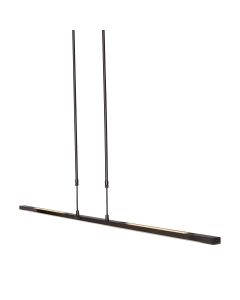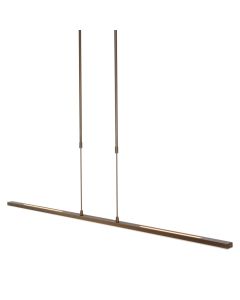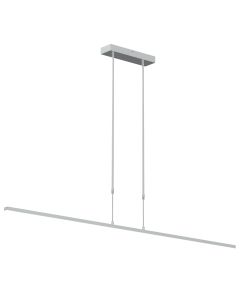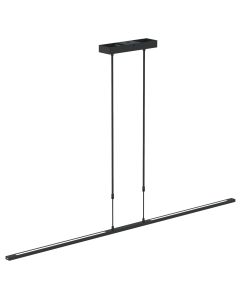
What is CRI?
When choosing lighting, most people focus on brightness (Lumens) and color temperature (Kelvin). However, another crucial factor determines how natural and pleasant light appears: the Color Rendering Index (CRI). This value directly affects how accurately colors are perceived under artificial light.
Steinhauer offers fixtures with built-in and replaceable LED modules with a minimum CRI of 90, ensuring true-to-life color representation. But why is this important? In this blog, we explain what CRI is, how it is measured, and in which situations a high color rendering index makes all the difference.
What is CRI?
CRI (Color Rendering Index) is a value measured on a scale of 0 to 100, indicating how accurately a light source renders colors compared to natural daylight.
- CRI 100 – Perfect color rendering, identical to daylight.
- CRI 90-100 – Excellent color accuracy, colors appear realistic and vibrant.
- CRI 80-89 – Good color rendering, but some shades may appear slightly muted.
- CRI 60-79 – Average color rendering, some colors may look distorted.
- CRI <60 – Poor color rendering, colors appear dull or unnatural.
The higher the CRI value, the better the color accuracy. Natural daylight has a CRI of 100, while standard LED lights typically fall between 70 and 85. At Steinhauer, we use LED modules with a CRI of at least 90, ensuring high-quality lighting.
Why Is CRI Important?
A high CRI is essential in many environments, including:
✔ Home lighting – Ensures walls, furniture, and decorations appear in their natural colors.
✔ Stores and displays – Products look more attractive and true to life.
✔ Art galleries and museums – Artworks need precise color rendering.
✔ Butcher shops and supermarkets – Meat and fresh produce look fresher and more appetizing.
✔ Fashion stores and hair salons – Clothing and hair colors appear accurately.
Lighting with a low CRI can make colors look dull, washed out, or inaccurate, negatively affecting the appearance of products and spaces.
Examples of CRI in Practice
1. CRI in Store Displays: The Example of a Butcher Shop
A butcher wants his meat to look fresh and high-quality in the display case. With low CRI lighting (<80), red meat may appear grayish or brown, which can discourage customers.
A high CRI light (90-100) ensures that meat retains its natural red and pink hues, making it look fresher and more appealing, increasing sales potential.
2. CRI in the Fashion Industry
Imagine buying a sweater in a store that looks perfect under the store’s lighting, but once you step outside, the color appears completely different. This issue occurs frequently with low CRI lighting, which distorts certain colors.
With LED lighting of CRI 90-100, clothing appears in its true shades, allowing customers to make better purchasing decisions.
3. CRI in Offices and Workspaces
A workspace with low CRI lighting can create a cold and sterile environment, leading to eye strain and decreased productivity.
Using lighting with CRI 90 or higher ensures natural and comfortable color rendering, improving employee well-being and efficiency.
Steinhauer LED Lighting: Minimum CRI 90 for True-to-Life Colors
At Steinhauer, we prioritize light quality and color accuracy. That’s why our fixtures with built-in and replaceable LED modules have a CRI of at least 90.
✔ True-to-life color rendering – Colors appear natural and vibrant.
✔ A warmer and more inviting atmosphere – Ideal for homes, stores, and offices.
✔ Less eye strain – More comfortable lighting for the eyes.
Whether for living rooms, offices, showrooms, or store displays, a CRI of 90+ ensures accurate color representation and superior light quality.
How to Identify a High CRI Light?
Not all manufacturers specify the CRI value of their lights. Here are some tips for identifying high-quality color rendering lighting:
✅ Check the packaging or product specifications – Reliable brands like Steinhauer always list the CRI of their fixtures.
✅ Compare with daylight – Hold an object under the light and see if the colors match how they appear in natural daylight.
✅ Look for color distortions – Low CRI lighting can make colors appear overly blue, yellow, or washed out.
A high CRI light ensures that rooms, objects, and products retain their true colors.
Conclusion: Why CRI Matters in Lighting
The Color Rendering Index (CRI) is a crucial factor when choosing lighting. A high CRI (90-100) ensures vivid, natural, and authentic colors.
Where is a high CRI most important?
✔ In stores and displays (e.g., butcher shops, fashion stores, supermarkets) to make products more appealing.
✔ In offices and workspaces to create a more pleasant and productive environment.
✔ In homes for a warm, cozy, and natural lighting experience.
At Steinhauer, we understand the importance of CRI: That’s why our LED products with built-in and replaceable modules offer a minimum CRI of 90, ensuring perfect color accuracy.
Looking for lighting with exceptional color rendering? Explore the Steinhauer collection and find fixtures with CRI 90+ LED modules for unparalleled natural lighting!







